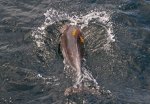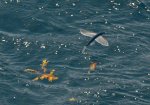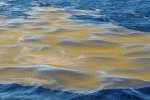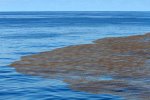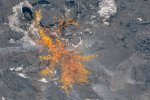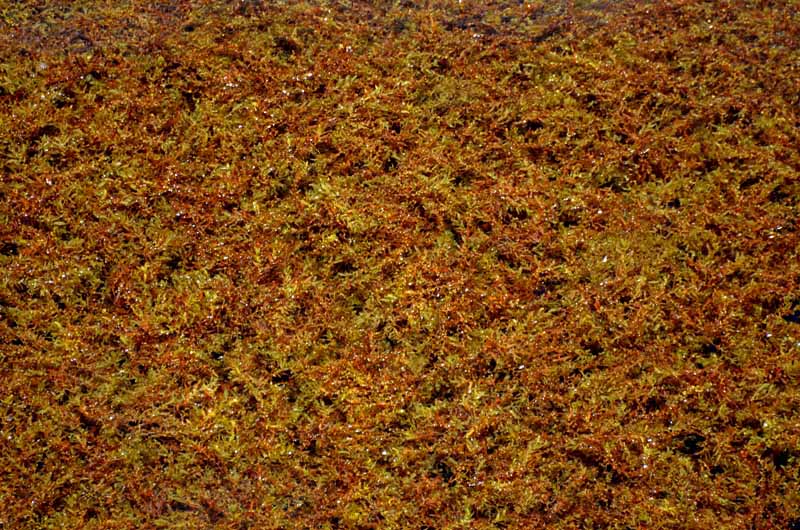
by Marijke de Boer
'The sea is orange' – this is what I wrote to the Green Heritage Fund of Suriname during the spring of 2012. I was conducting research in the offshore waters of Suriname and was surprised to see the huge amounts of Sargassum (algae) floating in large mats on the surface of the ocean.
Sargassum — from which the Sargasso Sea takes its name — was described by Christopher Columbus as 'great quantities of weed' floating in the ocean. Some 500 years later, in May 2014, seaweed began accumulating along the coast of Suriname and eventually washing up at Braamspunt.
These major 'seaweed beaching events' are documented in the Gulf of Mexico and more recently in the islands of the Lesser Antilles where, during the summer of 2011, a large amount of pelagic Sargassum washed ashore. Although non-toxic to humans these 'Golden tides' (the beaching of floating Sargassum) can smother whole coastlines resulting in large piles of rotten weed which can cause problems for nesting turtles and tourists alike. Turtle (post)-hatchlings are also known to have washed up in storm-driven Sargassum tides on the same nesting beach on which they might have hatched several weeks or even months before. In the case of Braamspunt, the 'Golden tide' was not too extensive, however, questions were raised as to why it had appeared and what exactly was it?
Sargassum is seaweed which spends its entire life adrift, and reproduces simply by growing and breaking apart or by making new floating thalli. It is quite leathery and tough and has features that resemble 'leaves' and a 'stem'. It also has well-developed gas bladders which allows it to float. It is one of the few sea weeds that do not need to attach to a hard substrate but instead drifts at the surface in a free-floating state. Sargassum is believed to start growing rapidly in spring by making new thalli in response to nutrients. The currents then spread the mats of Sargassum and this rapid expansion can spread over many kilometers, and is even capable of crossing the Atlantic.
In 2011 satellite data showed a large shift in the distribution of Sargassum with a significant increase in Sargassum-like detections in an area off northern Brazil, centered at about 7° N, 45° W, where previous detections had only revealed very small amounts (Gower et al., 2013). The increase in these detections started in April 2011 and reached a peak in July, returning to background levels by October when it is assumed that the aged thalli sink to the deep sea. The total amount at the time of the peak was in the region of three times more than the maximum total amount ever recorded by MERIS for the Gulf of Mexico (Gower & King, 2011). The satellite images in Figure 1 show the concentration of Sargassum developing off the coast of Suriname, and neighbouring countries, and clearly shows how it makes its way across the Atlantic to West Africa.
There are two species of floating Sargassum: Sargassum natans and Sargassum fluitans. They can be difficult to distinguish from a distance but at close range the characteristics of the structure of the leaves and the pods (gas bladders) are useful in differentiating between the two species (http://www.usm.edu/gcrl/sargassum/sargassum.identification.guide.php). However, we were warned by the Gulf Coast Research Laboratory that the characteristics can vary and identification of a particular sample may not always be straightforward. In the case of the Braamspunt Sargassum the pods were not 'tipped with spikes or small leaves' and the leaves were 'short-stalked and broad-shaped'. We were clearly dealing with Sargassum fluitans – the same species as we had identified previously whilst offshore in 2012.
The floating Sargassum mats create a valuable and unique habitat for many highly adapted and even endemic animal species. In 2012, we observed a variety of seabirds, fish, turtles and also dolphins in close proximity to these golden mats. Furthermore, and very important indeed, is the fact that Sargassum provides a nursery for young turtles where they feed and hide from predators (Witherington et al., 2012). Sargassum also acts as a spawning ground for many fish species, including flyingfish, marlin and tuna and is the only breeding location for the threatened European and American eels (Laffoley et al., 2013). The larvae of both the European eel and the American eel develop in the Sargassum mats, after which the young larvae will migrate to Europe or the East Coast of North America. In due course the adult eels will then migrate back to the Sargasso Sea to once again lay their eggs into these golden mats.
More recently the Sargasso Sea was described as 'the golden floating rainforest of the Atlantic Ocean' (Laffoley et al., 2013), a wonderful and fitting description. I write this piece in May 2015 from the offshore waters of Suriname where I am once again conducting research and as I look through my cabin porthole I can see the 'Suriname golden floating rainforest' drift by – and it is full of life.
All pictures by James Saulino and Marijke de Boer.
References
Gower, J. & King, S. (2011). Distribution of floating Sargassum in the Gulf of Mexico and the Atlantic Ocean mapped using MERIS. Int. J. Remote Sens. 32: 1917–1929.
Gower, J., Young, E. & King, S. (2013). Satellite images suggest a new Sargassum source region in 2011. Remote Sens. Lett. 4: 764–773.
Laffoley, D.d'A, Roe, H.S.J., Angel, M.V., Ardron, J., Bates, N.R., Boyd, L.L., Brooke, S., Buck, K.N., Carlson, C.A., Causey, B., Conte, M.H., Christiansen, S., Cleary, J., Donnelly, J., Earle, S.A., Edwards, R., Gjerde, K.M., Giovannoni, S.J., Gulick, S., Gollock, M., Hallet, J., Halpin, P., Hanel, R., Hemphill, A., Johnson, R.J., Knap, A.H., Lomas, M.W., McKenna, S.A., Miller, M.J., Miller, P.I., Ming, F.W., Moffitt, R., Nelson, N.B., Parson, L., Peters, A.J., Pitt, J., Rouja, P., Roberts, J., Roberts, J., Seigel, D.A., Siuda, A., Steinberg, D.K., Stevenson, A., Sumaila, V.R., Swartz, W., Trott, T.M. and Vats, V. (2011) The protection and management of the Sargasso Sea: The golden floating rainforest of the Atlantic Ocean: Summary Science and Supporting Evidence Case. Bermuda, BM, Sargasso Sea Alliance, 44pp.
Smetacek, V. & Zingone A. (2013). Green and golden seaweed tides on the rise. Nature, 504: 84-88.
Witherington, B., Hirama, S., Hardy, R. (2012). Young sea turtles of the pelagic Sargassum dominated drift community: Habitat use, population density, and threats. Marine Ecology Progress Series 463: 1-22.

